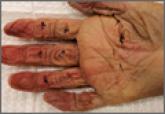Article

Partial Flexor Tendon Laceration Assessment: Interobserver and Intraobserver Reliability
- Author:
- Barker BJ
- Kolovich GP
- Klinefelter RD
Accurate assessment of partial-thickness flexor tendon lacerations in the hand is difficult owing to the subjectivity of evaluation. In this...
